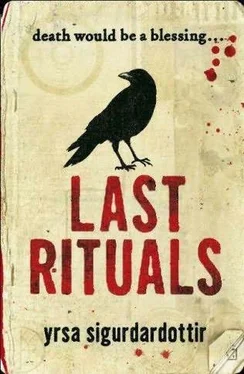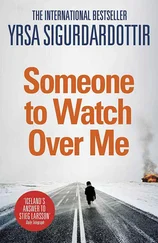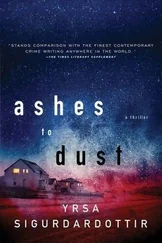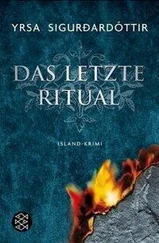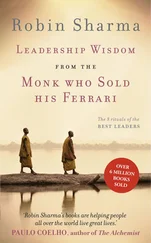"Hello," the man said, offering his hand. "Thrainn Hafsteinsson."
Thora and Matthew returned his greeting and introduced themselves.
"Do come inside," the doctor said in English so that Matthew would understand, and opened the door to his office. "Excuse me for being late," he added in Icelandic, addressing his words to Thora.
"That's fine," she replied. "The literature out there is so fascinating, I wouldn't have minded waiting a bit longer." She smiled at him.
The doctor looked at her in surprise. "Yes, quite." They entered the office where there was little in the way of empty space. The walls were covered with bookshelves filled with scientific works and journals of all sizes and descriptions, with the occasional filing cabinet arranged between them. The doctor walked behind a large tidy desk and sat down, inviting them to do the same. "Well, then." He put both hands on the edge of the desk as he said this, as if to emphasize that their meeting was formally beginning now. "I presume we'll be doing this in English."
Thora and Matthew both nodded.
He went on: "That won't be a problem, I did my doctorate in America. But I haven't spoken a word of German since I walked out of my school oral exam as a teenager, so I'll spare you that."
"As I told you on the phone, English is fine," Matthew said. Thora tried to suppress a smile at his German accent.
"Good," the doctor said, reaching out for a yellow plastic folder from the top of a pile of papers on his desk. He arranged it in front of himself, poised to open it. "I should start by apologizing for how long it took to get permission to show the autopsy documents in all their glory." He gave them an apologetic smile. "There's far too much bureaucracy surrounding this kind of case and it's not always obvious how to respond when the circumstances are unusual, as in this situation."
"Unusual?" Thora inquired.
"Yes," replied the doctor. "Unusual insofar as the family chose to appoint a representative to retrieve the autopsy results, and also because a foreign national is involved. For a while I was starting to think we'd need the signature of the deceased to squeeze permission out of the system."
Thora smiled politely, but could see out of the corner of her eye that Matthew's face was like a fossil.
The doctor looked away and continued. "Anyway, the bureaucracy surrounding it wasn't the only thing that made this case special, as I think you should realize before we begin." The doctor smiled again. "This was the strangest and most extraordinary autopsy I've ever performed, and I saw a thing or two when I was a student abroad."
Thora and Matthew said nothing and waited for him to continue. Thora was noticeably more excited than Matthew, who might as well have been a statue.
Clearing his throat, the doctor opened the folder. "Nonetheless, let us begin with what can be called the fairly normal aspects."
"By all means," grunted Matthew, and Thora tried to conceal her disappointment. She wanted to hear the strange parts.
"Well, the cause of death was asphyxiation by strangulation," the doctor said as he tapped the folder. "When we've finished I'll let you have a copy of the autopsy report and you can read the results in more detail if you want. As far as the cause of death is concerned, the main point is how the deceased was strangled. We think a belt was used, made of some material other than leather. Whoever did it used a lot of force when he or she tightened it; there are pronounced marks on the neck. And it's not unlikely that the pressure was maintained for far longer than was needed to kill him for some reasonpresumably in a mad fit of brutality or rage."
"How do you know that?" asked Thora.
The doctor rummaged through the folder and produced two photographs. He put them on the desk and turned them to face Thora and Matthew. They showed Harald's badly damaged neck. "You see that at the edge of the strangulation marks the skin was punctured in some places and burned by the friction. That suggests that the surface of the belt was slightly uneven. And notice, too, that whatever it was does not appear to have been regular in shapeit varied in width, judging by the differences in the breadth of the wound." The doctor paused while he pointed to one of the two photographs. "Another interesting thing is that down here at the base of the neck are signs of earlier wounds, not as serious but interesting all the same." He looked at them. "Do you know anything about this?"
Matthew spoke first. "No, nothing." Thora restrained herself, but she suspected the cause. "I'm sure they have nothing to do with the murder. But you never know." The doctor seemed satisfied with Matthew's answer; he did not press them further at least. He pointed to the other photograph, which was also of Harald's neck, but enlarged. "This is a close-up, and it shows how a piece of metal, the carved buckle of a belt or some other unknown object on the strap that was used, dug into the deceased's neck. If you look closely you can see it resembles a little daggerbut it could be something quite different. Of course, this is no plaster cast."
Thora and Matthew stretched over for a better look at the photograph. The doctor was right. A mark left by an indeterminate object was clearly visible on his neck. A scale at the bottom of the photograph showed that the object was eight to ten centimeters long and the outlines up the neck bore a fairly close resemblance to a small dagger or cross. "What's that?" Matthew asked, pointing to abrasions on either side of the mark.
"Something with sharp edges appears to have been behind the small object. These punctured the skin when the strap was tightened. That's the closest I've got."
"What happened to the belt or whatever it was?" Matthew asked. "Was it ever found?"
"No," the doctor replied. "The attacker got rid of it. He doubtless thought that we could have obtained a DNA sample from it."
"Could you?" asked Thora.
The doctor shrugged. "Who knows? But if it were found now, so long after the incident, the samples wouldn't be reliable." He cleared his throat. "Then there's the estimated time of death. That's a much more technical issue." The doctor flicked through the documents and removed several pages. "I don't know how familiar you are with such procedures, in terms of how we determine it?" He looked at Thora and Matthew.
"I have no idea," Thora said quickly. She saw that this annoyed Matthew, who did not say a word, but that didn't bother her.
"I suppose I should explain briefly what it entails so that you realize the results are neither some kind of magic nor irrefutable fact. They only express probability because the accuracy of the result depends on the accuracy of various information or clues that need to be collected."
"Collected?" repeated Thora.
"Yes, to make such an estimate we need to collect clues that can be found on or near the body itself and in its surroundings. We also make use of clues from the life of the deceased, for example, the last time he was seen before his death, when he last ate, his habits, and the like. This is especially important in the case of violent deaths like this one."
"Of course," said Thora, smiling at the doctor.
"The information or clues are then applied in various ways to produce the best estimate of the time of death."
"How?" Thora asked.
The doctor leaned back in his chair, clearly pleased at the interest she was taking. "There are two methods. The first is based on measuring changes in the body that take place at a known rate, such as rigor mortis, body temperature, and decay. The other method involves comparing information with known times: when the deceased ate the food that is in his stomach, how it has been digested, and so on and so forth."
"When did he die?" Matthew got straight to the point.
Читать дальше
